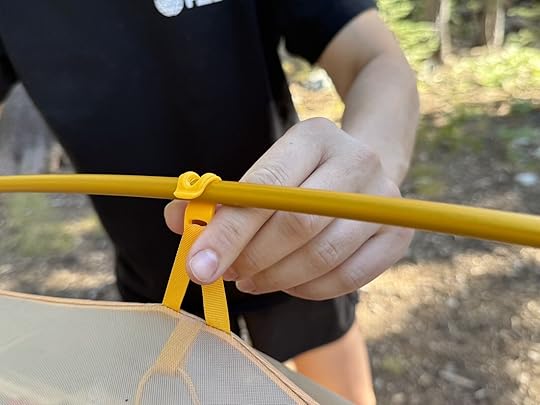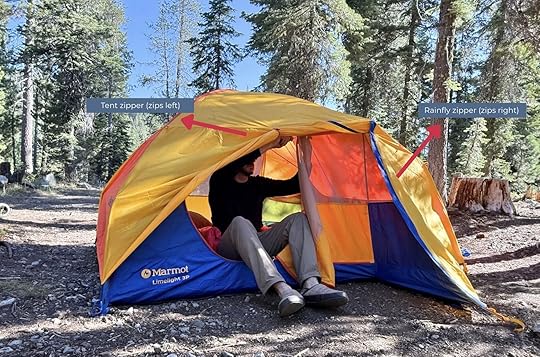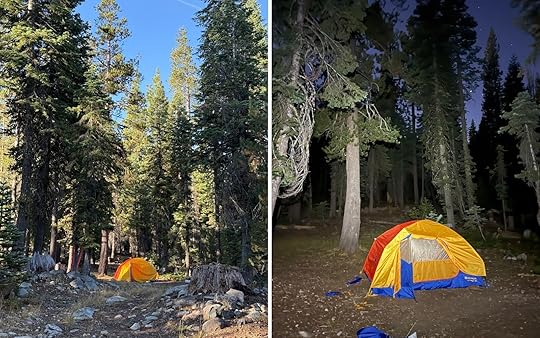Field-Tested in the Sierra Nevada: The Marmot Limelight 3P Makes Car Camping Extra Comfortable

If you’re a backpacker, you probably know that you usually have to sacrifice on one of three categories with outdoor gear: weight, size, or cost. And that’s true for tents. Ultralight tents that pack up into small packages usually cost a pretty penny, with far cheaper tents available — but they almost always take up more space and weigh more.
Fortunately, one of the nice things about car camping (camping where you can drive to your site) is that it doesn’t really matter how much your tent weighs, or how small it packs up. That means any tent will do — or so I thought.
I spent many years car camping with a relatively cheap tent. Actually, it was free: we found it on the ground while leaving Coachella in 2017. I later found out it came from Walmart and retailed for about $50. I thought it was fine until I tried a brand new tent from Marmot, and realized the right tent actually can make car camping way more pleasant.
After a few weekends of camping in the colorful Marmot Limelight Three-Person (3P) Tent, it’s clear it’s exactly what it promises to be: a mid-range, comfortable tent for car camping or close walk-in sites, with a few useful features that give it a leg up over comparable options. It’s a tent for campers who want their nights outside to be as comfortable and frustration-free as possible, with easy assembly, big doors for ventilation in fluctuating temperatures, and a smart design with space to stay organized.
Here’s what to know about the Marmot Limelight 3-Person, if you’re considering buying a new car camping tent.
We hope you love the gear we recommend! Just so you know, Matador may collect a small commission from the links on this page if you decide to make a purchase. Listed prices are accurate as of the time of publication.
Summary of our Marmot Limelight 3P testingCategory: TentsPrice: $359Trail weight: 5 lb, 15 oz.Best For: Car camping, festivals, walk-in campsitesBuy Now: $359Pros:
Roomy inside for two (tight but doable for three)Dual side vestibules to create dedicated space for each personEasy assembly thanks to color-coded materialsComes with matching tent footprintComfortable inside, even in temps ranging from 45 to 85 degrees FCons:
Tent zipper and rainfly zipper open on opposite sidesZipper flap fabric occasionally gets caught in the zipper
Set up and first impressions
 Photo: Suzie Dundas
Photo: Suzie Dundas Photo: Suzie Dundas
Photo: Suzie Dundas Photo: Suzie Dundas
Photo: Suzie DundasOut of the package, the Marmot Limelight 3P feels like any other tent, though it does come with a footprint (something you usually have to buy separately). The poles come in their own bag, as do the stakes, making it easy to keep everything organized.
I went through a range of emotions setting up the Limelight 3P. It seemed confusing at first, partially because the tent has a triangle-shaped internal vestibule on each side. When lying flat, those vestibules flop to the sides, giving the tent a “T” shape when viewed from above, rather than a rectangle. I spent a few minutes trying to make sure I had it lined up correctly on the gray fabric footprint until I noticed something obvious: the tent and rainfly are color-coded. The blue poles and clips line up with the blue loops, while yellow poles and clips line up with yellow loops. This also made setting up the rainfly quite simple and quick, despite the fact that the dual oversized doors can make it tricky to tell what part of the tent is what when you first unfold it, especially if they’re unzipped.

The bent tent poles create extra living room inside, but take up a touch more space when packed. Photo: Suzie Dundas
But as soon as I realized it was color-coded, things became much easier. It took under five minutes to set up once I knew what I was doing. One person can set it up no problem, but with two people, you’re probably looking at more like a two-minute assembly time. Otherwise, setup is like any other tent, with bungee cords that snap together to build the frame, and clips that attach the tent to the poles.
The Marmot Limelight 3P is almost entirely freestanding, as the tent and rainfly are pole-supported, but each vestibule requires one stake. If you’re on a surface where you’re unable to use stakes, just put something heavier on the inside of the vestibules, and they’ll more or less work the same way (though they may flap a bit in heavy wind). The rainfly door attaches to the same stake, so expect the door to flap a bit if you can’t use stakes. However, the rainfly doors each have a small loop on top to keep them rolled up and open, if the flapping gets annoying.
Weight and packability
The Marmot Limelight 3P packed up. Photo: Suzie Dundas
The Limelight 3P lands in the middle of the pack on size and packability. Of course, these are considerations that matter more when backpacking. The curved poles take up a little more space than straight poles, and it packs into a 24-inch-long bag with a 6.5-inch diameter. It weighs 7 pounds, 2 ounces when packed, or about six pounds with just the essentials. That’s almost exactly the same weight as the beloved REI Half Dome 3P (7 pounds, 2.5 ounces), and heavier than the Big Agnes Copper Spur UL 3P (3 pounds, 13 ounces, but that one costs $200 more).
For car camping, we found the size and weight minimally important. That said, it’s still relatively light, and could be used for walk-in campsites, especially if you divide the weight between two hikers. Many non-technical tents, like the old one I had from Walmart, are bulkier and can weigh in well over 10 pounds, which is a bit too much to lug to a campsite that requires any amount of walking.
Durability and materials

The poles are lightweight aluminum, not carbon. Photo: Suzie Dundas
Though the Limelight 3P is about the same packed size and weight as comparable tents, it’s made with more durable materials. This means it’s more likely to withstand wear, tears, rips, and abrasion. The floor is made from 68D polyester taffeta, making it thicker than floor fabric on comparable tents like the REI Half Dome 3P (40D ripstop nylon) and the Big Agnes Copper Spur 3P (20D ripstop nylon). Add in the fact that it comes with a 68-denier polyester footprint to put under the tent, and you suddenly have a super-durable combo that resists damage, even on rocky, rough ground covered in pointy acorns and sharp rocks. The rainfly is thicker than many comparable options, and is the same material you’ll find on tents from brands like Kelty, MSR, and Coleman.
A key difference in materials between the Limelight 3P and higher end backpacking tents is that the Limelight uses aluminum for the poles, not carbon. It’s less expensive, but weighs a bit more. If you’re looking for an ultralight backpacking tent, you’ll want to check out the Limelight UL (ultralight) version.

Inside the Limelight, with plenty of space for two people to spread out. Photo: Suzie Dundas
The Limelight 3P is just the right size for two campers who want extra room to spread out. For car camping, my husband and I each have a 30-inch-wide self-inflating pad, so our tent needs to be at least 60 inches wide. The Limelight is 65 inches across, easily fitting our pads side-by-side. The pre-bent poles and steep sidewalls turned the interior from a cramped pyramid into a comfortable dome-shaped space, allowing us to sit up side-by-side without leaning into the tent walls. This is especially important for cold-weather camping, as touching the sides of the tent can make condensation drip onto your sleeping bags and sleeping pad.
The Limelight is a three-person tent, and three people would probably be able to sit side-by-side, but you’d be touching hips. When it comes to sleeping, the person in the middle would have to put his or her head at the other side of the tent. It’d be tight, but possible with mummy-style camp pads, and the layout would mean no one had their face directly next to another person.
Another feature that makes the tent quite livable are the dual doors, with one on each side of the tent. This allows each person to easily exit, avoiding the dreaded middle-of-the-night wakeup when one person has to climb over the other to go pee in the woods.

The tent’s top half is all fine, bug-proof mesh. Photo: Suzie Dundas
I run cold, so I didn’t get warm in the tent at all, even sitting in it for brief periods during the middle of the afternoon. However, I see where someone could get a little warm, as the rainfly has no vents, mesh, or flaps. However, the vestibules between the mesh door and the rainfly’s sides are quite large, providing decent airflow and eliminating any condensation on 40-something degree nights. But if you like having a strong breeze, you’ll need to either skip the rainfly entirely, or sleep with the rainfly rolled up over both doors to create cross-ventilation.
During our testing, we never got cold, even when the temperature dropped into the 40s. We also didn’t notice any condensation, even with cool temps outside and our body heat inside. That’s not the case with our cheap tent from Walmart, which always felt like it was letting drafts and cool air in through the seams.
We had clear skies during our testing weekends, so we had to simulate rain by spraying a garden hose on the tent when we got home. It performed as well as we’d expect a brand-new tent to perform. While the inside of the tent felt a little clammy with water on the outside, it was still very much dry, and you could see water beading off and rolling down. And the included footprint can be used strategically in rain to direct water around the tent, rather than under it. Our expectation is that this level of water resistance would continue, provided the tent is cared for properly (for example, not left out in the sun for weeks on end).
For most people, it should be waterproof enough for any conditions you’d want to camp in. However, it’s designed to be a three-season tent, so we’d recommend something more technical (and likely more expensive) for winter and snow camping, or camping in extreme conditions.

Photo: Suzie Dundas
Easy-peasy (once you figure out the color-coded thing). The only catch is that you need to put it away properly for it to fit in the bag. This is easy: lay the tent, rainfly, and footprint on top of one another; fold them into thirds, then roll them up around the poles like a sleeping bag.
My favorite feature: dual inside vestibules

The inside vestibules (right) create dedicated space for each person, while the hook-and-loop system (left) keeps the doors rolled up and out of the way when needed. Photo: Suzie Dundas
The Limelight 3P has one useful feature we really liked: a small inside vestibule on each side, giving each person in the tent space to keep his or her items handy and organized. With smaller tents, I often find myself searching around in the dark at night for things like my Kindle, socks, or phone. But with the dual vestibules, each person has a private spot to keep items where they won’t get it anyone else’s way and won’t get lost under sleeping bags and pillows.
A few other features that were immediately useful include multiple hanging inside pockets for smaller items like headlamps, and a light diffuser pocket at the very top. The opaque fabric softens light, turning a headlamp into a tent ceiling light. We also appreciated the hooks to keep the rainfly and tent doors rolled up and out of the way.

The tent door and rainfly zippers open in opposite directions. Photo: Suzie Dundas
Our main gripe with the Limelight 3P is that the tent doors unzip in the opposite direction of the rainfly zippers. In practice, this means you have to unzip the tent door entirely to use the rainfly zipper. Sometimes, brands do that so that any rain or wind that comes through the rainfly zipper doesn’t hit directly into the tent door zipper. But since the tent door is mesh on top, I’m not sure why it’s designed this way. It’s a small annoyance, and many people may not even notice it.
A secondary gripe, if we’re being picky, is that the fabric flap covering the rainfly zipper got caught several times in the actual zipper, especially when we were in a hurry. A little jiggling or a quick pull remedies the issue, and it’s something we’ve noticed on backpacking bags and sleeping bags, too. However, it’s an understandable design choice: flaps are an inexpensive way to add water resistance to a zipper, instead of using a bulkier YKK waterproof zipper.

With nearly neon colors, you’ll never have trouble finding your tent. Photo: Suzie Dundas
If you usually camp in muddy or wet conditions, the MSR Elixir 3P may be a better choice. That’s because the tent floor is 70D nylon with a 3,000mm waterproof rating, so it’s less likely to absorb moisture in extended rainy conditions (but does not include a footprint). The Elixir sleeps three people side-by-side, rather than putting the middle person at the opposite end.
The Big Agnes Copper Spur UL3 is both lighter (at four pounds) and packs up smaller. But it has the thinnest materials and the lightest waterproof rating, so you’ll need to choose your site more carefully in rainy conditions, and it may not stay quite as dry on the bottom if there’s rain and water running around your tent for hours on end.
If you’re an REI shopper, the REI Half Dome 3P is a viable alternative to the Limelight 3P. The floor has just a touch more waterproofing than the Limelight floor, but the materials are a bit thinner, making them potentially more susceptible to damage. It’s also a smidge pricier, at $399.
If you like the size and vestibules on the Limelight 3P, but are looking for a tent better suited to backpacking, the Limelight UL (Ultralight) 3P tent could be a better choice, weighing in at 3.5 pounds with aluminum poles. It packs to a 20-inch-long, seven-inch diameter package, though it’s usually advisable to divide tent weight between hikers, rather than carrying it in its original bag. The weight savings also comes at a premium, with the Limelight UL 3P tent retailing for $549 — roughly $200 more than the non-ultralight version I tested. It does not include a footprint.

Photo: Suzie Dundas
The Marmot Limelight 3P is an ideal car camping tent for two people, with plenty of room to move and useful dual inside vestibules.Curved tent poles make the packed size a bit larger, but create a roomy interior that feels less like a pyramid and more like a dome.Setup was easier than expected, and dual doors mean middle-of-the-night breaks won’t wake everyone in the tent.The lack of mesh on the rainfly could make the interior warm if you’re camping in extremely hot conditions.While it’s relatively light for a car camping tent, at six pounds, we’d recommend the ultralight version to backpackers.Buy Now: $359More like thisTravelThe Gear Matador Editors Love For Spring HikesHow we tested:
About our tester: Suzie is Matador Network’s commissioning editor and a happy camper, having camped everywhere from Alaska and Colorado to Chile and Vietnam. She’s used and tested backpacking tents from brands like Fjällräven, Sierra Designs, The North Face, and MSR, in conditions ranging from 90-degree heat to heavy snow. She’s been reviewing outdoor gear for multiple publications for years and has a strong understanding of technical materials, features, and what does and doesn’t matter in the Great Outdoors.She field tested this in the Sierra Nevada, at remote drive-in campgrounds. It was dry and dusty, yet also full of mosquitoes, with temperatures in the high 40s at night and low 90s during the day.
Matador Network's Blog
- Matador Network's profile
- 6 followers




